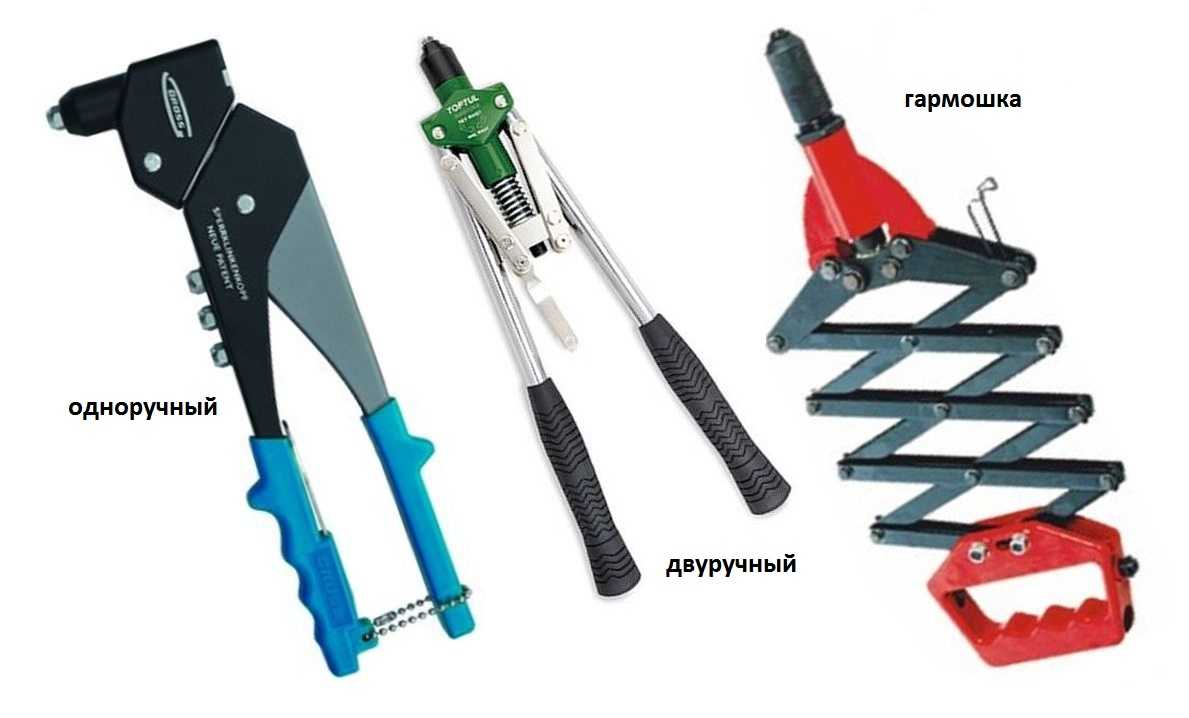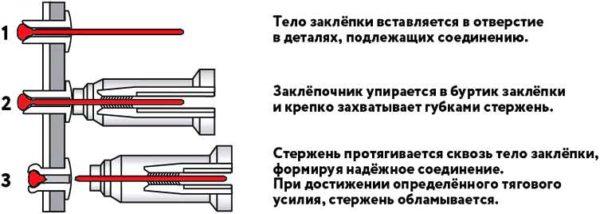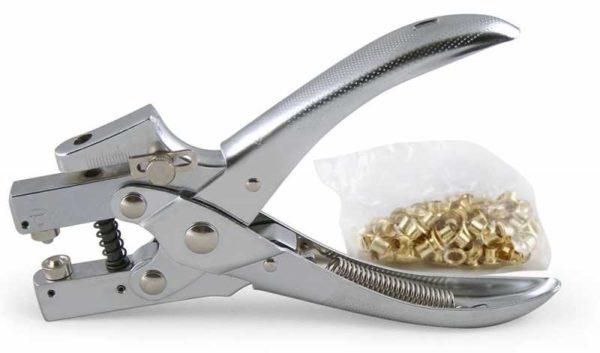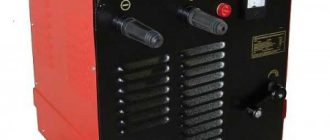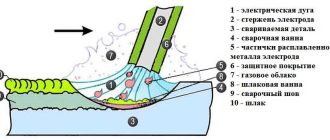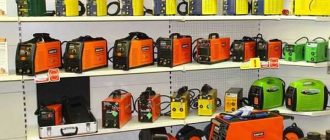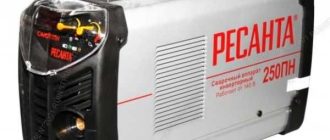Suvirinimas yra puikus būdas sujungti metalus, tačiau ne visada tai patogu ar įmanoma. Alternatyva - kniedijimas. Tačiau norėdami įrengti kniedes, turite pasirinkti kniediklį. Kaip tai padaryti, skaitykite toliau.
Straipsnio turinys
Kas yra kniediklis ir kaip jis veikia
Kniedikliai arba kniedytuvai - tai kniedžių montavimo įtaisai. Yra specialių įrankių, skirtų įvairių tipų tvirtinimo detalėms. Yra atskirų, skirtų traukiamosioms, įsukamoms kniedėms. Yra ir universalių modelių, tačiau jie priklauso profesionalių įrankių grupei, atitinkamai kainuoja solidžiai.
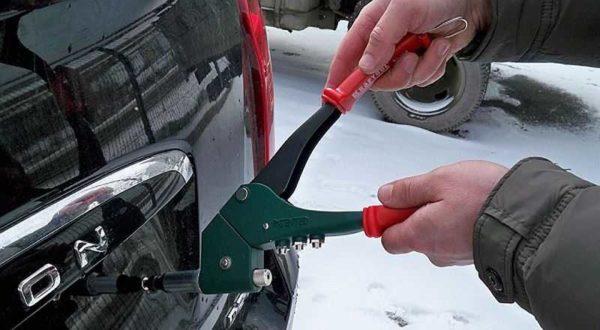
Norint teisingai pasirinkti kniedijimo įrankį, pageidautina suprasti, kaip jis veikia. Nepriklausomai nuo to, su kokio tipo kniedėmis prietaisas dirba, kniedijimo principas visada yra toks pats: prietaisas suploja antrąją (tolimąją) kniedės dalį, suformuodamas uždaromąją galvutę. Gali skirtis tik išlyginimo būdas:
- Montuojant traukiamąsias kniedes, žnyplės sugriebia ir traukia strypą. Strypo gale yra rutuliukas, kuris remiasi į kniedės korpuso kraštą ir jį sutrupina. Pasiekus tam tikrą jėgą, strypas nulūžta.
- Sraigtinių kniedžių montavimas skiriasi. Tuščiaviduriame korpuse yra sriegis. Į šią detalę įsukamas tinkamo skersmens varžtas. Įsukus jis pradeda traukti aukštyn kniedės kraštą, dėl to plastikinis metalas suplonėja (žr. toliau pateiktą vaizdo įrašą).
- Tuščiavidurės kniedės (pistoletinės kniedės) yra paprasčiausiai išsiplėtusios su kūgio formos antgaliu. Pistoletinės kniedės naudojamos neapkrautose vietose, tačiau dažniau ne statybose, o apdailos darbams arba jungiant detales iš odos, audinio ir pan.
Apskritai procesas yra aiškus. Kaip matote, skiriasi tik tai, kad vienu atveju reikia traukti strypą, kitu - sukti varžtą, o trečiuoju - spaudžiamas kūginis antgalis. Rinkdamiesi kniedžių rūšį, atkreipkite dėmesį į tai, kad traukimo įrankis yra nebrangus, tačiau už sraigtines kniedes paprastai tenka pakloti nemažai. Tai daugiausia taikoma tik varžtinėms kniedėms. Na, ir tai, kad jos yra tuščiavidurės - nesandarios.
Disko tipo pasirinkimas
Prieš rinkdamiesi kniediklį turite suprasti, kas tai yra kniediklis. Pradėkime nuo pavaros.
MILWAUKEE 2550-20 M12 RIVET TOOL akumuliatorinio kniediklio vaizdo apžvalga.
Buitiniam naudojimui įsigykite rankinius kniedijimo įrankius. Tačiau net ir šį "paprastą" įrankį nėra lengva išsirinkti. Pirmiausia stebina kainų diapazonas - nuo 5$ iki kelių šimtų dolerių. Kaip čia orientuotis? Iškart pasakysime, kad per brangus imti vienkartiniam naudojimui tikrai neverta, taip pat per pigus. Likusią dalį būtina suprasti.
Rankinių (mechaninių) kniediklių tipai
Yra trijų tipų rankiniai kniedžių montuotuvai:
- viena ranka;
- dviem rankomis;
- akordeonas.
Viena ranka skirti mažo dydžio - iki 5 mm - tvirtinimo detalėms. Jie skiriasi tuo, kad jų darbinės rankenos su montavimo ašimi sudaro 90° kampą. Tai reiškia, kad rankenos nukreiptos žemyn. Tai patogu, nes galima dirbti viena ranka. Trūkumas - mažas dydžių, su kuriais gali dirbti prietaisas, "diapazonas".
Dviejų rankų įtaisai pasižymi dideliais matmenimis, jais galima montuoti ir didelio skersmens - iki 8 mm - kniedes. Juos galima atskirti iš išvaizdos - ilgų rankenų, kurios yra vienoje plokštumoje su darbinėmis žnyplėmis. Dviejų rankų kniediklį tikslinga rinktis, jei planuojate naudoti didelio skersmens kniedes.
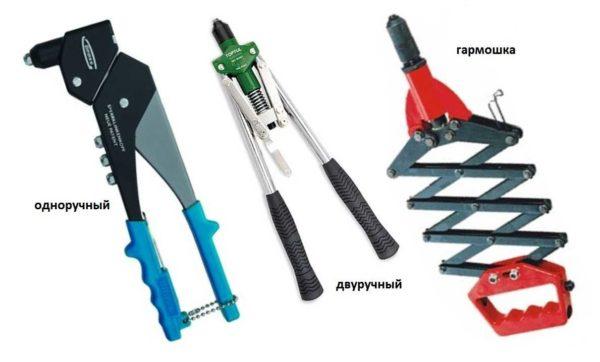
Mechaninės kniedės "akordeonas" dažniau naudojamos su didelių dydžių tvirtinimo detalėmis. Naudojant tas pačias "akordeono" kniedes galima montuoti didelių matmenų tvirtinimo detales dedant mažiau pastangų. Toks prietaisas paprastai turi brangesnį įrankį, jį dažniau naudoja profesionalai.
Pasirinkti rankinių kniedijimo mašinų tipą nėra labai sunku. Jei jums reikia patikimos mašinos, rinkitės iš dviejų rankų modelių. Jų įrenginys paprastesnis, beveik nėra ko sulaužyti. Esant normaliai kokybei, jos yra nelūžtančios. Jei klijuosite tik smulkias tvirtinimo detales - ne daugiau kaip 2-3 mm, patartina imti vienrankę. Su jomis dirbti patogiau.
Rankinio kniedžių montuotojų atrankos kriterijai
Taigi, jei jums reikia pasirinkti rankinio tipo kniediklį, atkreipkite dėmesį į šiuos parametrus:
Kitas dalykas, į kurį atkreipkite dėmesį, yra rankenos. Ant jų esančios guminės pagalvėlės turi būti pagamintos iš geros gumos. Pačios rankenos turėtų būti patogios, kad galėtumėte dirbti greičiau ir ilgiau. Taip pat atkreipkite dėmesį į galimybę užfiksuoti rankenas, kai jų nenaudojate, - yra speciali vielinė kilpa, kuri laiko rankenas kartu. Sandėliuojant tai patogu ir svarbu.
Kniedžių ištraukiklio pasirinkimas
Dažniausiai tenka dirbti išimant (ištraukiant) kniedes. Jos yra patogios, nebrangios. Jų montavimo įrankis per daug nekainuoja. Be pirmiau nurodytų parametrų, norėdami išsirinkti ištraukiamųjų kniedžių kniediklį, taip pat turėtumėte atkreipti dėmesį į kai kurias specialias savybes ir galimybes.
Dabar jau žinote, kaip pasirinkti kniedžių ištraukimo tvarkyklę. Išsirinkę kelis jūsų poreikius atitinkančius modelius, apžiūrėkite juos ir palaikykite rankose. Jei įmanoma, porą kartų išbandykite darbą. Taip bus lengviau suprasti, su kuriuo įrankiu jums patogiau dirbti, ir bus lengviau pasirinkti.
Gręžimo ir (arba) gręžtuvo priedas ir jo pasirinkimo ypatumai
Didelį darbo frontą atliekant rankinėmis kniedėmis, rankos labai pavargsta. Žinoma, yra belaidžių, tačiau jų kaina visai nedžiugina. O jei jas taip pat naudojate tik retkarčiais, elektrinį įrankį pirkti netikslinga. Tokiu atveju galite rasti kompromisą - įsigyti priedą prie gręžtuvo ar atsuktuvo, skirtą kniedėms montuoti.
Tai yra mažas adapteris (antgalis), kuris įstatomas į griebtuvą. Jų yra varžtinėms ir ištraukiamosioms kniedėms. Jei pageidaujate, galite rasti ir po kitų tipų tvirtinimo detalių.
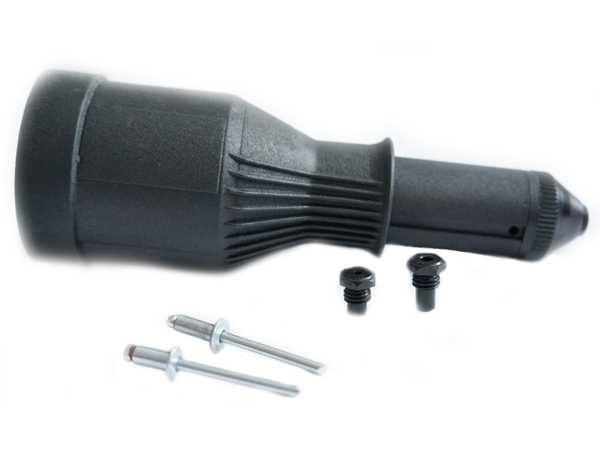
Gręžtuvo su kniedėms skirtu priedu veikimo principas nesiskiria - tas pats įrankis ištraukia kaištį, o paskui jį nulaužia. Išskyrus tai, kad nulūžusias "uodegas" reikia ištraukti patiems, perjungus grąžtą į atbulinę eigą. Naudojant sraigtines kniedes, taip pat reikia veikti atbuline eiga - ištraukti antgalį iš sumontuotos tvirtinimo detalės.
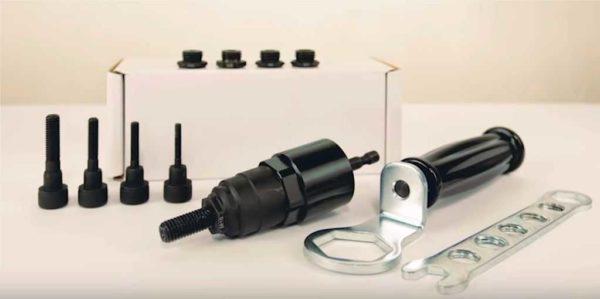
Kniedijimo antgaliai ant grąžto pasirenkami panašiai: pagal antgalio tipą, dydį ir medžiagą. Na, o kotas turi atitikti elektrinio įrankio griebtuvą. Taip pat atkreipkite dėmesį į tai, ar yra rankena. Tai ne itin svarbus parametras, tačiau padidina naudojimo patogumą. Gręžtuvas su prisukamu antgaliu yra sunkus ir nestabilus. Todėl dirbant būtina antgalį laikyti ranka, fiksuojant jo padėtį. Kad nereikėtų laikyti antgalio, uždedama rankena. Šioje versijoje patogiau naudoti mašiną, o padėtį galima tiksliau kontroliuoti.
Kaip pasirinkti kniedijimo įrankį: gamintojai ir kainos
Rinkdamiesi konkretų modelį daugelis žmonių remiasi kainomis. Tik skirtumas labai didelis - yra labai pigių ir beveik tokios pat išvaizdos, bet daug kartų brangesnių. Netgi dešimtis kartų brangesni. Iš karto verta pasakyti, kad net ir vienkartiniam darbui pirkti labai pigią kniedę - pernelyg rizikinga. Ji gali visai neveikti arba veikti per kelmą.
Pavyzdžiui, jei norite sukniedyti tik tvorą, net ir tokiu atveju turėsite sumontuoti daugiau nei šimtą kniedžių. Jei įrankį teks išardyti po kas 2-3 kniedžių, jis jums tikrai nepatiks. Norėdami išsirinkti gerai veikiantį kniediklį, atkreipkite dėmesį į vidutinį kainų intervalą.
Jei kniediklį ketinate naudoti profesinėje veikloje, turėtumėte rinktis brangesnį. Firminis - jūsų nuožiūra, bet iš profesionalių arba pusiau profesionalių modelių kategorijos. Galbūt jie nesiskiria konstrukciniu požiūriu, tačiau turi didesnį resursą, tarnavimo laiką. Tai reiškia, kad jie pagaminti patikimiau ir kokybiškiau. Ir tai paaiškina kainų skirtumą - naudojamos brangesnės / kokybiškesnės medžiagos.

